
Wound Dressings Page Menu: 1 2 3 4 5 6 7 8 9 10 11 <<First
Wound Dressings in the Golden Age of Piracy, Page 11
Concluding Example - Dressing a Complex Fracture
This brings us to the last page of the article on dressings.
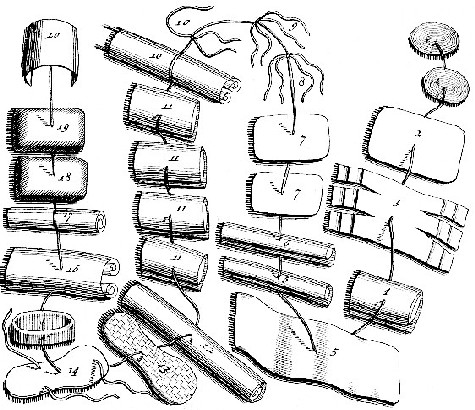
The Dressings for a Complex Fracture,
from A Description of Bandages and Dressings
by Charles Gabriel Le Clerc, Figure 43, p. 87 (1701)
We have covered a lot of ground as there were several different types of dressings used during the golden age of piracy.
What better way to review what we have learned than by way of an example supplied to us by Charles Gabriel Le Clerc in his book A Description of Bandages and Dressings?
Most of what has been used from his book so far has actually been from his introductory notes and first few pages. The bulk of Le Clerc's book outlines the bandages required in various different operations using unique drawings to show the dressings required and the order in which they are to be used.
To summarize the various dressings and conclude this discussion, let's look at how Le Clerc dressed a complex fracture - that is, a fracture with an external wound. Because this is a rather long explanation, I am going to show the whole diagram here and then break it into components for easier reference in the text that follows. Note that Le Clerc is proving the Cadillac of dressings for such a fracture - a surgeon at sea may not have had access to all the things mentioned by Le Clerc, but he could probably make do with what he needed.
"The Dressing for a Complicate Fracture of the Leg. See Fig. 43.
1. Pledgits armed with a Liniment proper for the Wound, which must be dressed after the same manner as other Wounds.
2. An Emplaster to cover the Pledgits, and the whole Wound.
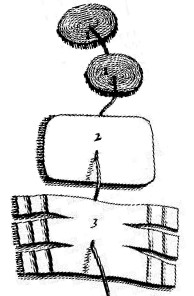
Comp. Fracture Dressings 1-3,
from A Description of Bandages and
Dressings, Le Clerc, Fig 43 (1701)
3. A Bandages with eighteen Tails, to be used instead of the simple Roller, to prevent stirring the Patient's Leg at each Dressing. To make the Bandage with eighteen Tails, Take three pieces of Cloth, as long as the Leg, and large enough to go round it, and to cross over it; lay these Cloths one over the other, and Stitch them in the middle [he's violating the stitching rule here]: Cut these three Cloths at both Ends, so that the upper Cloth, that is, that which must immediately cut the Leg, may be longer by the breadth of a Finger, than that in the middle, and may be one Finger's breadth shorter, than that which it lies over:
The Reason of these Gradations is, because the Tails are more easily taken, each in Particular by the end, to apply them over the Leg. Besides, the Cloths that are first applied round the Leg, thicken it [which may be why stitching the cloth would not harm the wound], and for this Reason, the last must be larger, that they may embrace them; when the Cloths are thus cut of an unequal length at their ends, divide 'em lengthways into three equal Pieces, but cutting them towards the middle, where you must leave three Inches in breadth undivided: By this Section, there will be nine Tails on each side, that is, eighteen in all, from whence this Bandage takes its Name.
Before these are laid round the Leg, let the whole Cloth be dipt in Oxycrate, warm Wine, or some other convenient Liquor [liquid medicine]. Put this Bandage under-neath the Ham [the thigh], and over the Junks [large folded cloths - see #10 for details], first laying a Compress on it, to prevent the Pus from fouling it: In applying this, begin with the middle Tail, which you must bring smoothly round the Leg, pass your Hand on the other side, to take the middle Tail on the opposite side, which answers to the former, or to speak more properly, is a continuation of it. Bring these two Laps over one another; then raise the other Pieces of the first Row after the same manner; observe not to lay these circularly round the Leg, but a little obliquely passing one over the other, and so this Bandage will be firmer. After you have bound up this Leg, with the first six Tails, lay on a Longitudinal Compress on each side of it."1
"4. A Compress in one Double, to be laid on the Junk [a large folded cloth - see #10 for details], under the Leg, before any of the Tails are raised: This serves to receive the Pus, which flows from the Wound, that it may not spoil the Bandage, which cannot be taken off and put on again, without stirring the Part; a Thing to be avoided as much as may be.
5. A single Compress of Linnen, to embrace the Leg, and cover the Pledgits, and an Emplaster; it must be large enough for this purpose; the ends too must pass over one another, and it ought to be near as long as the Leg; it must be dipt in
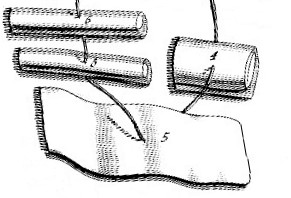
Complex Fracture Dressings 4-6, from A Description of
Bandages and Dressings, Le Clerc, Fig 43 (1701)
Oxycrate [vinegar and water], or Wine heated, before it be applied. This Compress is laid on the Bandage with eighteen Tails, before it be wrapt round the Part.
6. Two Longitudinal Compresses, of six or seven Inches in length, and an Inch and a half broad, in several Doubles, which must be laid on the Leg, the one on the one side, and the other on the other side of the Leg, on the Tails which are to be brought round it; but observe not to lay them on the Wound: Two Compresses are sufficient, because the Wound takes up one part of the Leg.
I do not think any Splints of Wood ought to be laid on these Compresses, as is done in Fractures, where there is no Wound, lest too great a Compression create mischievous Accidents: Let a Servant keep the two Compresses on, and raise the second Row as you did the first, beginning with the Cloth in the middle, which must always be wrapped round the fractured Bone: In the last Place, raise the third Row, beginning in the same manner, with the Cloth in the midst, which you must bring over the Fracture, observing to lay each Tail a little obliquely, because in passing over another, the Bandage is more firm, as was said before."2
7. Two large Pastboards, shaped round at the End, which embrace the whole Leg, and keep on the Dressings; These Pastboards must be dipt in Oxycrate, to soften them, that so they may fit more neatly and closely on the Part, to whose Figure they will accommodate themselves, when they are dry: Observe, these Pastboards must be straighter below than above, because the Leg is slenderer there.
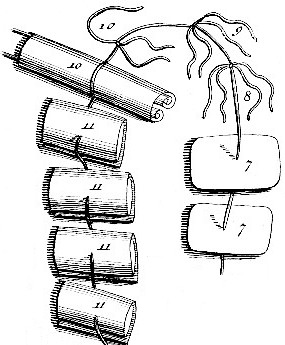
Complex Fracture Dressings 7-11, from A Description
of
Bandages and Dressings, Le Clerc, Fig 43 (1701)
8. Three Ribbons or Tapes, to keep the Pastboards on the Part: The middle one is to be tied first, making the Knot, and over this a simple Bow Knot, on the out-side of the Leg.
9. Three Ribbons or Tapes, laid on the Bed, under the Leg, at equal distances one from the other, with which the Junks [a large folded cloth - see #10 for details] are tied.
10. Junks to lay the Leg in. These must not go above three Inches beyond the Knee, for if they went to the upper end of the Thigh, this being thicker than the Leg would not be so well supported, and the Ligature made round the Thigh, would press them, and draw aside the Leg. The Junks are made with a Cloth doubled, or in three Leaves, thus: Take a Staff about three Inches longer than the Leg, put some Straw about it, and bind this round with a Fillet; then roll up the Staff encompassed with Straw at either end of the Cloth, and these are the Junks in which the Patient's Leg is to be laid.
11. Four thick square Compresses in several Doubles, which are applied between the Junks and the Leg, to fill up the Vacuities, that is one on each side under the Ancles, and one on each side the Leg, below the Knee, in the Cavities which are there: When the four Compresses are put in the aforesaid Places, tie the Junks with the three Ribbons or Tapes laid under them, making a Knot with a simple Bow above, on the outside the Junks."3
"12. A Longitudinal Compress laid all along the Tibia, between the Junks, and over all the Dressings before you tie the former: This Compress serves to stay the Ribbons. Some Practitioners reject this.
13. A small Quilt which is sowed on the Soal [sole] made of Pastboard, to support the Patient's Foot and keep it streight. Tho' this Situation of the Foot is fatiguing and not natural; yet it is necessary, because it keeps the great Tendon extended, which otherwise
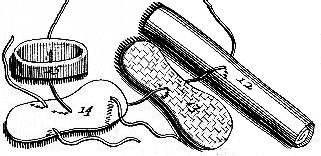
Complex Fracture Dressings 4-6, from A Description of
Bandages and Dressings, Le Clerc, Fig 43 (1701)
would be shortned, and the Patient after his Recovery, could not go without some support.
14. A Soal made of Pastboard, which ought to be almost of the Figure, and bigness of the Foot: This is that which is to be covered with the Quilt just now mentioned: You must fasten three Ribbons to it, one at the end, which is to be pinned on the middle of the Leg, to the Longitudinal Compress, and one on each side of it, which must cross and have their ends pinned to the middle of the Junks, the one on the one side, and the other on the other. This crossing stays the Soal, that it cannot incline to one side or the other.
15. A Roll or Ball as soft as can be made, to support the Patient's Heel: This Roll is perforated, that so the Heel bearing on the Hole, may not be hurt.

Comp. Fracture Dressings 16-20, from A Description
of
Bandages and Dressings, Le Clerc, Fig 43 (1701)
Some Practitioners rather chuse false Junks after this manner."4
16. False Junks to support the great Tendon, that the Heel may not be hurt, as it is in the former way: Take pretty large and long Linnen-Cloth, roll it on the two ends, as you see in the Figure and support the Tendon on this Cloth, between the two Heads.
17. A Roll made of soft Cloth on which the Heel rests, when the Patient is weary of the false Junks: These Dressings may be changed alternately, according as you find he complains.
18. A Pillow laid under the Ham to fill up the Cavity, for fear, lest the Leg receive an ill Direction.
19. A Pillow to be laid under the Leg.
20. A Cradle of Wood to keep off the Cloaths. Nevertheless you must take care to lay something very light and warm over the Leg in Winter, for fear of Cold."5
1 Charles Gabriel Le Clerc, A Description of Bandages and Dressings, p. 82-3; 2 Le Clerc, p. 83-4; 3 Le Clerc, p. 84-5; 4 Le Clerc, p. 85-6; 5 Le Clerc, p. 86

